Comparing Interpretations Questions (Edexcel GCSE History): Revision Note
Exam code: 1HI0
Summary of Question 3 (b)
Question 3 (b) asks you to explain the difference between Interpretation 1 and Interpretation 2
The interpretations used in Question 3 (b) will be the same interpretations used in Questions 3 (c) and (d)
Amount of marks | 4 |
|---|---|
The time that you should spend on the question | No more than 5 minutes |
An example of the type of question you may encounter can be seen below:
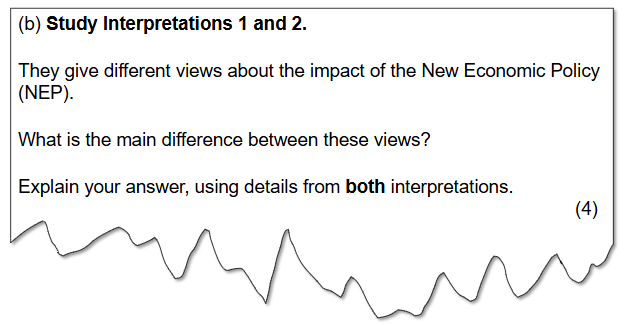
In previous years, this question has focused on the following topics in Russia and the Soviet Union:
Year of Exam
Question Topic
2018
Problems faced by the Provisional Government (opens in a new tab)
2019
The achievements of the Five-Year Plans (opens in a new tab)
2020
Conditions for workers in towns, 1928–41 (opens in a new tab)
2021
Challenges facing the Bolsheviks, 1921–24 (opens in a new tab)
2022
Reasons why Stalin won the struggle for power against his rivals (opens in a new tab)
2023
The main reason why Stalin’s purges began (opens in a new tab)
2024
The experience of women in the Soviet Union under Stalin’s rule
What is an interpretation question?
An interpretation is someone’s point of view about a historical event, person or time period
Interpretations focus on different ideas or evidence, so they may not always agree
These interpretations could be written:
After the event
By people who were there at the time
By historians
You will be given two interpretations from the Sources/ Interpretations Booklet
This is a separate booklet from your answer paper
It includes the key interpretations you’ll need for Section B
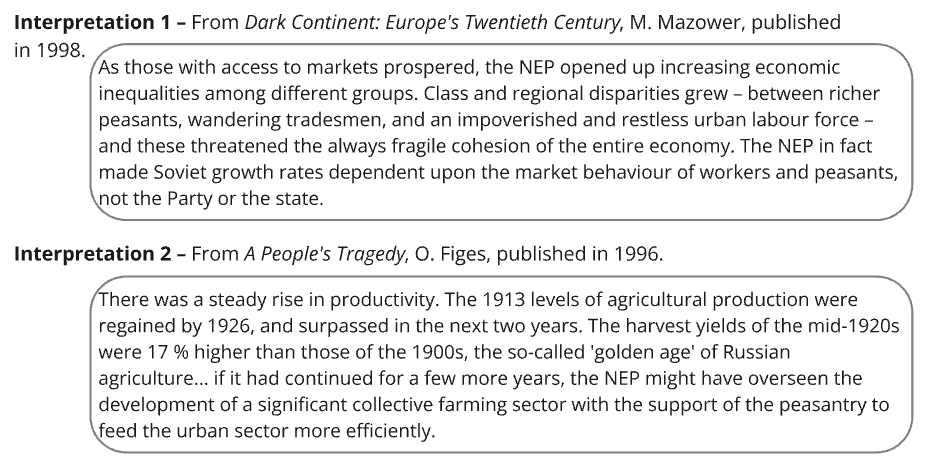
Question 3 (b) — "What is the main difference?"
The interpretations used in Question 3 (b) will always be different from one another
In the Edexcel Russia and the Soviet Union, 1917–41 topic, interpretations are different based on the following themes:
Political developments (e.g. Tsarist or Bolshevik policies)
Social and cultural developments (e.g. the cult of Stalin)
Economic developments (e.g. the effects of War Communism or the Five-Year Plans)
"What is the main difference?" question structure
Your answer needs to:
Identify and explain the main difference in content between Interpretation 1 and Interpretation 2 (In)
Support your explanation with a short quote or clear summary from each interpretation (In)
To achieve full marks, you need to include both Interpretation 1 and Interpretation 2 in your answer
Worked example of a "What is the main difference?" question
Worked Example
3 (b) Study Interpretations 1 and 2. They give different views about the impact of the New Economic Policy (NEP).
What is the main difference between these views?
Explain your answer, using details from both interpretations.
(4)
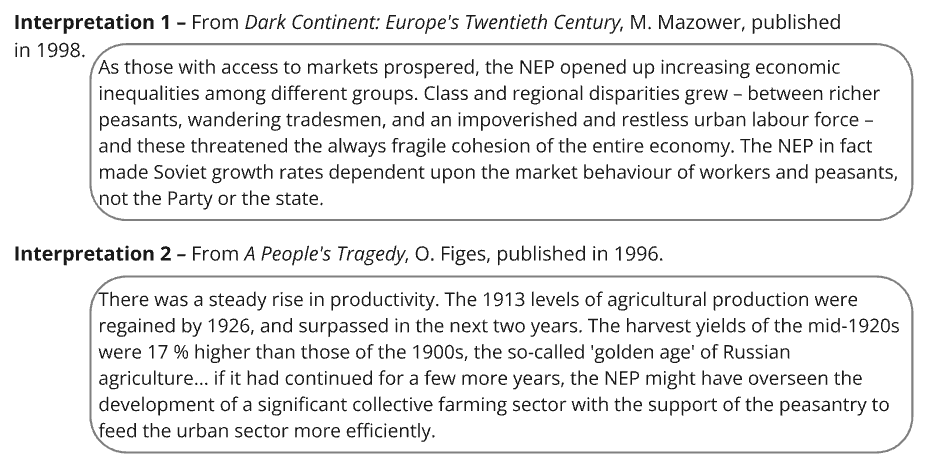
Answer
Interpretations 1 and 2 have different views about the impact of the New Economic Policy (NEP) in the 1920s (In). Interpretation 1 argues that the NEP caused significant social issues. It says the NEP made "economic inequalities among different groups" worse (In). Interpretation 2 presents the NEP as a period of successful economic recovery (In). It says "there was a steady rise in productivity" and that harvest yields were "17% higher than those of the 1900s" (In).
Summary of Question 3 (c)
Question 3 (c) asks you to explain why the interpretations are different
You should not repeat what you have written in Question 3 (b)
The interpretations used in Question 3 (c) will be the same interpretations used in Questions 3 (b) and (d)
You can use Sources B and C in this question
However, if you choose not to use them, you can receive full marks
Amount of marks | 4 |
|---|---|
The time that you should spend on the question | No more than 5 minutes |
An example of the type of question you may encounter can be seen below:
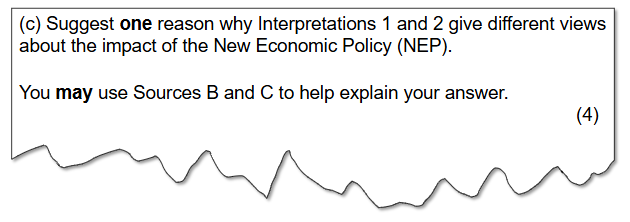
In previous years, this question has focused on the following topics in Russia and the Soviet Union:
Year of Exam
Question Topic
2018
Problems faced by the Provisional Government (opens in a new tab)
2019
The achievements of the Five-Year Plans (opens in a new tab)
2020
Conditions for workers in towns, 1928–41 (opens in a new tab)
2021
Challenges facing the Bolsheviks, 1921–24 (opens in a new tab)
2022
Reasons why Stalin won the struggle for power against his rivals (opens in a new tab)
2023
The main reason why Stalin’s purges began (opens in a new tab)
2024
The experience of women in the Soviet Union under Stalin’s rule
Question 3 (c) — "Why are interpretations different?"
Both Interpretation 1 and Interpretation 2 may have different interpretations due to:
The types of sources they have used
For example, some interpretations may have placed more weight on political sources whereas others may use more economic sources
The authors' focus on short-, medium- or long-term developments or effects
For example, some interpretations may have focused on the short-term effects of an event, such as the Kronstadt Mutiny
Others may focus on the long-term effects
Do not refer to provenance
You will not receive any marks for an explanation focused on the provenance
"Why are the interpretations different?" question structure
The most common way of structuring this answer is by using Sources B and C
One of the sources will support the argument made in Interpretation 1
The remaining source will agree with the argument given in Interpretation 2
Do not use Source A in your answer, as you will not receive any marks
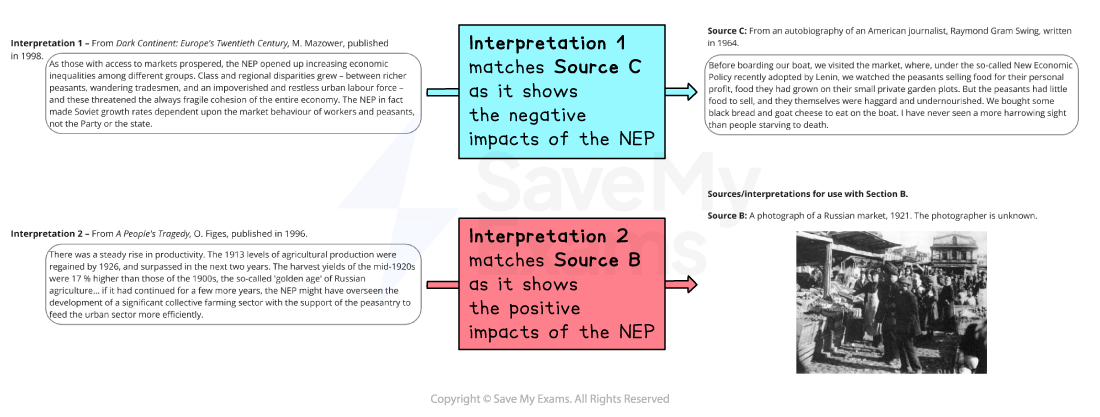
Using this method, you would use the following structure in your answer:
State that the historians' viewpoints differ because they have given weight to different sources (In)
For Interpretation 1, state that they have looked at sources such as Interpretation 1's matching source (either Source B or C)
Use quotes or details from the source and from Interpretation 1 to show how they connect (In)
Repeat this structure for Interpretation 2, using its matching source
Do not use irrelevant information from the interpretations that are not based on the question
For example, a student may focus on the mention of collective farming in Interpretation 2 and discuss collectivisation
This is not relevant and will not receive marks
Worked example of a "Why are the interpretations different?" question
Worked Example
3 (c) Suggest one reason why Interpretations 1 and 2 give different views about the impact of the New Economic Policy (NEP).
You may use Sources B and C to help explain your answer.
(4)
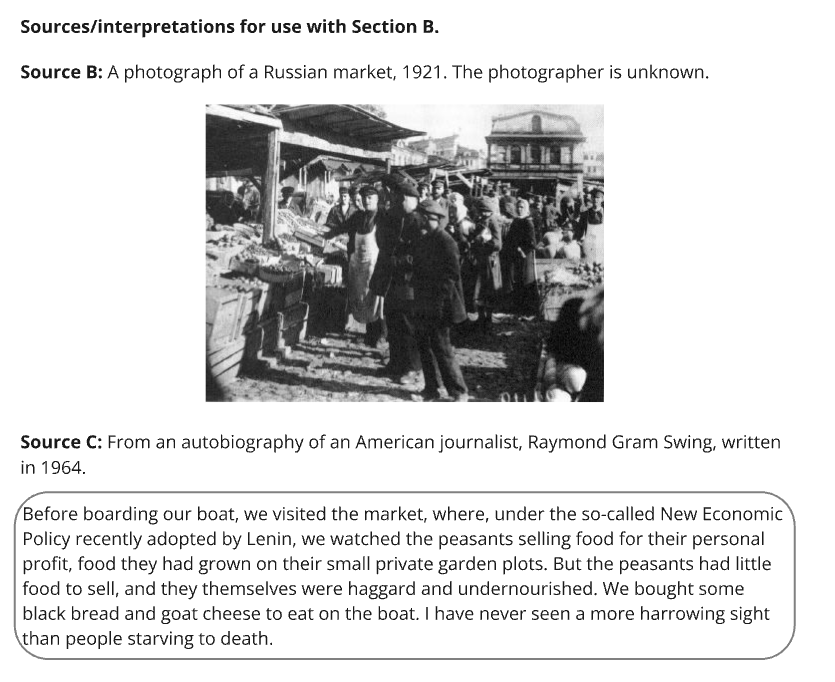

Answer:
Interpretations 1 and 2 give different views about the NEP because they have given weight to different evidence (In). The author of Interpretation 1 may have studied sources such as Source C, which shows that the NEP caused serious suffering. The American journalist describes peasants as "haggard and undernourished" and says he witnessed "people starving to death". This supports Interpretation 1’s claim that there was an "impoverished and restless urban labour force" (In). However, Interpretation 2 will have studied sources such as Source B. It shows peasants selling food, which supports the idea that the NEP led to improved productivity and a return of market activity. This evidence matches Interpretation 2’s argument that "harvest yields of the mid-1920s were 17% higher than those of the 1900s" (In).

Unlock more, it's free!
Did this page help you?